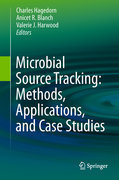
Microbial source tracking: methods, applications, and case studies
Hagedorn, Charles
Blanch, Anicet R.
Harwood, Valerie
Understanding the origin of fecal pollution is essential in assessing potential health risks as well as for determining the actions necessary to remediate the quality of waters contaminated by fecal matter. As a result, microbial source tracking (MST) has emerged as a field that has evolved and diversified rapidly since the first approaches were described only a decade ago. In response to the emergence of MST, there have been three large multi-laboratory method comparison studies (two in the US and one in Europe), plus numerous workshops, book chapters, and review articles dedicated to synthesizing information on the topic. Furthermore, a federal (USEPA) guide document describing the uses andlimitations of MST methods was published in 2005, and a book dedicated to MSTas an emerging issue in food safety was published in 2007. These documents provide a collective body of literature on MST that is both conflicting and complementary, often repetitious, and difficult to condense and interpret. In addition, it does not reflect the current diversity of MST approaches with different organisms, newer methodologies such as quantitative PCR, and anthropogenic chemicals, nor does it embrace the scope of MST research being conducted around the world. The three editors of the book, all with extensive MST expertise, have developed chapters and invited authors who reflect the rich diversity andtruly international scope of MST. The unifying theme throughout the book is the design of more standardized approaches to MST that include performance criteria (regardless of method or organism), plus recommendations for field study design and MST implementation. The editors intend that this book will serve asa valuable reference for all those who are involved with This comprehensive book taps the expertise of many of the leading researchscientists from an international assemblage, and considers a geographic rangefrom the U.S. to China, New Zealand, Australia, and the EU. It addresses subjects ranging from the fundamentals of MST methods, their pros and cons, and performance criteria necessary during method development, and application, to case studies from beach, agricultural, and urban watersheds. This is most comprehensive book on this subject in years INDICE: Chapter 1: Overview. Chapter 2: Performance Criteria. Chapter 3: Library-dependent Source Tracking Methods. Chapter 4: Library-Independent Source Tracking Methods. Chapter 5: Viruses as Tracers of Fecal Contamination. Chapter 6: Phage Methods. Chapter 7: Pathogenic Protozoa. Chapter 8: Chemical-Based Fecal Source Tracking Methods. Chapter 9: Statistical Approaches for Modeling in Microbial Source Tracking. Chapter 10: Mitochondrial DNA as Source Tracking Markers of Fecal Contamination. Chapter 11: Community Analysis-Based Methods. Chapter 12: Public Perception of and Public Participation in Microbial Source Tracking. Chapter 13: Use of Microbial Source Tracking in the Legal Arena: Benefits and Challenges. Chapter 14: Applications of Microbial Source Trackingin the TMDL Process. Chapter 15: Relating MST Results to Fecal Indicator Bacteria, Pathogens, and Standards. Chapter 16: Minimizing Microbial Source Tracking at All Costs. Chapter 17: Environmental Persistence and Naturalization of Fecal Indicator Organisms. Chapter 18: Agricultural and Rural Watersheds. Chapter 19: Case Studies of Urban and Suburban Watersheds. Chapter 20: Beaches and Coastal Environmenta. Chapter 21: Source tracking in Australia and New Zealand: Case Studies. Chapter 22: Microbial Source Tracking in China and Developing Nations. Chapter 23: A National Security Perspective of Microbial Source Tracking. Chapter 24: Applications of Quantitative Microbial Source Tracking (QMST)and Quantitative Microbial Risk Assessment (QMRA). Chapter 25: Food Safety and Implications for Microbial Source Tracking. Chapter 26: Training Future Scientists: Teaching Microbial Source Tracking (MST) to Undergraduates. Index.
- ISBN: 978-1-4419-9385-4
- Editorial: Springer New York
- Encuadernacion: Cartoné
- Páginas: 480
- Fecha Publicación: 13/07/2011
- Nº Volúmenes: 1
- Idioma: Inglés
